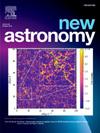Exploring the evolution of a non-static plane symmetric universe with cosmic strings and LVDP in f(Q) gravity
IF 2.1
4区 物理与天体物理
Q2 ASTRONOMY & ASTROPHYSICS
引用次数: 0
Abstract
In this study, we have investigated the non-static plane symmetric space–time with perfect fluid containing cosmic string in the frame work of gravity in which the non-metricity scalar describes the gravitational interaction. To find exact solutions for the field equations, we assume the metric potentials relation as , where is an arbitrary constant and the linearly varying deceleration parameter , where and are constants. We estimate the best-fit values of the model parameters using the Observational Hubble Data (OHD) comprising 31 data points of Cosmic Chronometers (CC) and the Pantheon+SHOES dataset comprising 1701 data points, employing the minimum chi-square method and the Markov Chain Monte Carlo (MCMC) technique, yielding and for OHD, and and for Pantheon+SHOES dataset. The evolution of the deceleration parameter indicates transition from an early decelerating phase to the current accelerating expansion phase of the universe in our model. Furthermore, the evolution of the deceleration parameter predicts a future transition into a super-acceleration phase of the universe. Moreover, to explore some key cosmological quantities such as energy density, pressure, equation of state parameter, the string tension density, we consider the quadratic form of the gravity model, specifically , where , , represent the model parameters. The equation of state parameter in our model exhibits a smooth transition from the radiation-dominated era to the matter-dominated era, and eventually to the dark energy era. The present-day values of for the OHD dataset and for the Pantheon+SHOES dataset suggest that the universe is currently in a quintessence phase,where dark energy behaves as a dynamical component rather than a simple cosmological constant . This behavior of equation of state parameter supports the physical viability of our model and confirms that the universe is undergoing accelerated expansion. Additionally, we further evaluate the physical validity of the model by analyzing the energy conditions and assessing its stability through the squared speed of sound test.
探索在f(Q)引力下具有宇宙弦和LVDP的非静态平面对称宇宙的演化
本文研究了在非度规标量Q描述引力相互作用的fQ引力框架下,具有含宇宙弦的完美流体的非静态平面对称时空。为了找到场方程的精确解,我们假设度量势关系为eh=sm,其中m≠12是任意常数,线性变化的减速参数qt= - kt+n - 1,其中k≥0和n≥0是常数。我们使用哈勃观测数据(OHD)(包含31个数据点的Cosmic Chronometers (CC))和Pantheon+SHOES数据集(包含1701个数据点)估计模型参数的最佳拟合值,采用最小卡方方法和马尔可夫链蒙特卡罗(MCMC)技术,得出OHD数据集n=2.08−0.10+0.09和H0=74.07−2.32+2.30,Pantheon+SHOES数据集n=2.80−0.07+0.07和H0=74.63−0.22+0.21。减速参数的演化表明,在我们的模型中,宇宙从早期的减速阶段过渡到当前的加速膨胀阶段。此外,减速参数的演化预测了宇宙未来向超加速阶段的过渡。此外,为了探索能量密度、压力、状态方程参数、弦张力密度等关键宇宙学量,我们考虑了fQ引力模型的二次形式,即fQ=α q2 +β q +γ,其中α、β、γ代表模型参数。在我们的模型中,状态参数ω的方程呈现出从辐射主导时代到物质主导时代,最终到暗能量时代的平滑过渡。OHD数据集的ω0= - 0.9037和Pantheon+SHOES数据集的ω0= - 0.6632表明,宇宙目前处于精华阶段,暗能量表现为一个动态成分,而不是一个简单的宇宙常数ω= - 1。状态方程参数的这种行为支持了我们模型的物理可行性,并证实了宇宙正在加速膨胀。此外,我们进一步通过分析能量条件和通过平方声速测试评估其稳定性来评估模型的物理有效性。
本文章由计算机程序翻译,如有差异,请以英文原文为准。
求助全文
约1分钟内获得全文
求助全文
来源期刊

New Astronomy
地学天文-天文与天体物理
CiteScore
4.00
自引率
10.00%
发文量
109
审稿时长
13.6 weeks
期刊介绍:
New Astronomy publishes articles in all fields of astronomy and astrophysics, with a particular focus on computational astronomy: mathematical and astronomy techniques and methodology, simulations, modelling and numerical results and computational techniques in instrumentation.
New Astronomy includes full length research articles and review articles. The journal covers solar, stellar, galactic and extragalactic astronomy and astrophysics. It reports on original research in all wavelength bands, ranging from radio to gamma-ray.
 求助内容:
求助内容: 应助结果提醒方式:
应助结果提醒方式:


